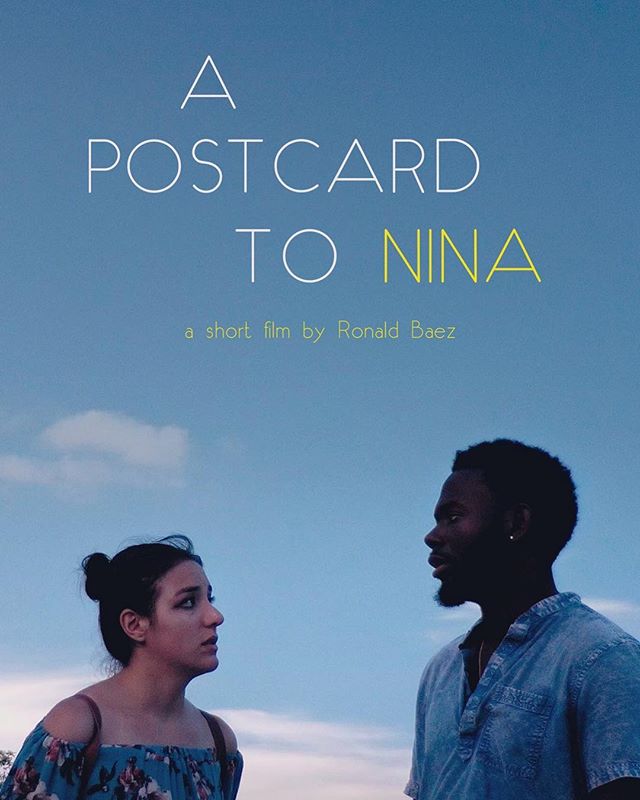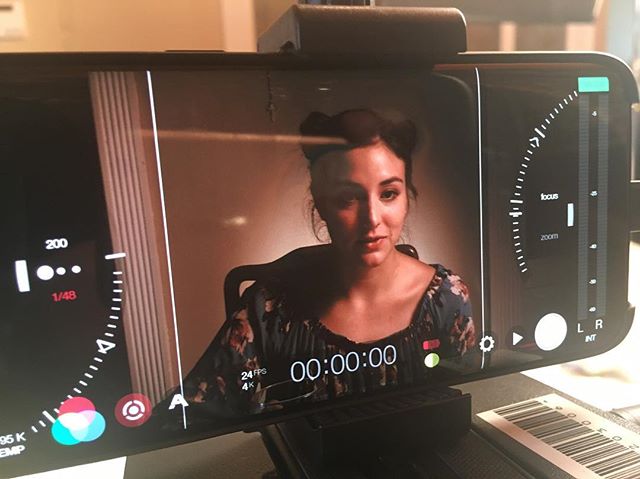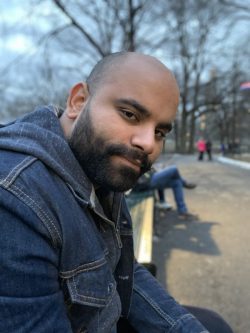Beautiful Film Shot on Samsung Galaxy S8: Filmmaker Interview
One of the most impressive submissions we received this year from a technical point of view was a film called “A Postcard To Nina”. The short was masterfully constructed by Caribbean-American screenwriter, director, and award-winning immersive media artist, Ronald Baez. While this thought-provoking tale is one of the most polished, professional we’ve received (not shot on an iPhone), it’s also a beautifully shot and acted.
“Longtime Instagram penpals Jean and Nina meet in person for the first time, re-defining their relationship as they stumbling through a deceptive, although well-meaning dinner with Nina’s ultra-conservative father.”
We asked Ronald Baez how he achieved so much with so little…
What is the story behind your film?
The film is based on a song by Swedish singer-songwriter Jens Lekman also titled “A Postcard To Nina”. When I heard it, I heard it’s story through the multi-cultural lens of my hometown of Miami, since I have never been to Sweden. It was touching, and I imagined the story’s central conflict being communication, so I set out to explore that concept using language, religion, race, and sexuality, which are very complex concepts to intertwine in the context of the culture of Miami.
I felt the story might be able to expand and comment on the importance of communication further if it was told from a Miamian cultural perspective, so we set out to do that.
What were the steps which led you to make it?
Most of pre-production was spent screen-testing mobile devices and navigating multi-lingual dialogue with actors. The technical side of things was led by my relentless and incredibly talented DP Kevin Berriz, as well as my producer, editor, and colorist Eddy Moon, while I focused on the performances with our cast.
Finding the right device, the right lenses, and the right color space to tell our story was a Herculean task, and we were often confronted with a myriad of choices which we wanted to diligently explore. So, a lot of time and work went into arriving at specific choices for big ticket items like the device and lensing. But also developing things that an audience would likely not realize were integral to the making of the film, like the workflow.
The actors really brought the script to life, each in their own way in their own tongue, pun intended! The performances were diligently crafted throughout the rehearsal process, with a lot of details focused on creating seamless conversation despite cultural and linguistic obstacles.
Our actors really did amazing work getting the film’s conversational style down and even managing after weeks of rehearsal to improvise a great deal of what ended up on screen. I’m incredibly indebted to them for their professionalism and diligence in taking on such a daunting task so brilliantly.
Ultimately, we feel these months of work really show up on screen, and we couldn’t be prouder of how the film turned out.
Why did you choose a smartphone to film with?
I wanted to shoot this particular film on a mobile device to create a natural limitation that would highlight the themes of the film; particularly limitations to communication, in an attempt to confront and embrace those limitations, and to comment on how communication often occurs nowadays. Our phones are so integral to how we see the world, each other, and ourselves today, so I wanted to experiment in that video space.
Still, there were real challenges that we needed to confront with the choices we were making both technically and in terms of tackling such an intensely multi-lingual script. Ultimately, I feel these choices result in a story which is uniquely told, and focuses in on experimenting with both craft and medium, which is important to me as a storyteller working in a medium which is constantly and rapidly evolving both technologically and in terms of cultural representation.
What equipment did you use?
We shot on a Samsung Galaxy S8 using FiLMiC Pro and Moment lenses for the film’s cinematic sequences. The film’s Instagram sequence as well as the final shot of the film were shot on the phone’s native lens using a combination of FiLMiC Pro and the phones native video capture app.
Grip and electric were run a lot more traditionally than other aspects of production would let on. We used traditional cinema lights (Mole Richardsons, Joker HMIs, Kino Flos, etc) along with traditional grip equipment to compose and shape our images. That aspect very closely mirrored similar considerations taken in traditional cinema production.
Same with sound- a Rode Boom Kit, Sennheiser G3s, and a Zoom F4 multitrack recorder captured all of the film’s audio, including the Instagram sequences.
For camera movement we used a combination of the DJI Osmo Mobile 2, as well as traditional slider dolly rigs customized to handle the phone mount and weighed down to facilitate ease of use and stabilization. The longer, more fluid tracking is all on the DJI with more simple trucking motions being captured on the slider.
Though we shot the film flat, Eddy Moon created a customized workflow in pre-production which allowed us to design the image system with heavy consideration being taken on post-production throughout the process of shot-listing and into production.
Ultimately, we edited on Avid, using a combination of Avid, After Effects, and DaVinci Resolve to arrive at our final product. I can’t overstate the importance of Eddy Moon’s work throughout post, particularly his work in color correction. So much of the film would simply be lost without the intense amount of creativity he brought to bear in this technical space. It’s damn impressive, and does so much to service the film.
On the computer front, Eddy Moon refuses to run post on anything but Macs, so he kind of forced our hand in that one. He’s the post-master, so to speak, so he gets whatever he wants on that front.
How much did you know about filmmaking before you made this film?
A good amount. The entire above the line team, including myself, are experienced filmmakers who adjunct as production and post-production faculty at the New York Film Academy’s South Beach campus. Our DP Kevin Berriz has a master’s degree in cinematography from CalArts.
We had a pretty solid understanding of what we were doing, so all of our choices were very deliberate. That said, the experience of filming “Nina”, as we call it, was extraordinarily unique. All these tools we’ve grown accustomed to having at our disposal suddenly changed in function or utility.
It was a humbling experience which made all of us marvel at the brilliance of filmmakers who are currently experimenting in the mobile space, creating some of the most beautiful things I’ve ever seen, some of them with little to no formal training. It goes to show the genius and ingenuity of artists around the world today, and I’m honored and humbled to be considered amongst any one of them.
What did you like/not like about filming with a phone?
Two words: DYNAMIC RANGE! Coming from a traditional filmmaking background, it seemed everything was either well-lit, or completely washed out/crushed to death. This was a HUGE challenge and something we ultimately had to embrace wholeheartedly, working it into dialogue timing, blocking, staging, and themes throughout production and post. It was really difficult to deal with, but the challenge was awesome.
In contrast, I LOVED the fact that we were able to use a skeleton crew of about 13 people to make the movie. The simplicity of the rigs as well as the increased mobility of the camera made the set a very intimate space, which I wholly prefer as a film director.
Often, sets can be very chaotic places, the pressure of which is often highlighted by the size of the set itself. I LOVED my tiny crew on this one! With a small crew, each crew member becomes an integral part of telling the story, and I cannot have been happier working in that space.
Has making the film changed your life in any way?
This film is very personal to me. I made this film while dealing with the ups and down of an ultimately amicable divorce, so my life is completely different for having made it. The details of that particular experience, I’m afraid, may require a drink or two before they can be divulged! Thus unfortunately, you’ll have to settle for a “Yes, very very much,” in the meantime.
How successful was the film, personally and in gaining an audience for your work?
We’re still very much navigating the festival circuit with the film, so the full spectrum of the film’s success has yet to be revealed. That said, we’re extraordinarily proud of the film, and audiences thus far have had nothing but positive experiences watching the movie, which is the ultimate reward for any filmmaker. In this sense, I’ll say it’s been a stunning success.
Looking back on the movie, is there anything you’d have done differently?
Absolutely not. Every little mistake, every little glitch arrives at a beautiful work that lots of people come together to create. The journey and the people you take it with is the most important part of that process, and being that the process was so intensely personal for me, I wouldn’t change a single thing if I could.
How important are film festivals that give these kind of films a platform for you?
Extraordinarily important. Though things are quickly changing, I don’t know that the industry writ large has fully embraced films shot in nontraditional mediums like mobile devices.
I think festivals like this have the primary function of introducing innovative stories and storytellers to the world. Without them, a large collection of brilliant stories and storytellers would go unnoticed. Film festivals like MoMo concerned with innovation in storytelling are truly doing amazing work in progressing this cause, and I look forward to watching them grow and being introduced to new works and storytellers from around the world interested in challenging the status quo.
It’s one of the most exciting communities in our industry, and I’m so grateful to be part of it!
You can find more info, including some behind the scenes photos and videos on the official website.
Eager to learn more?
Join our weekly newsletter featuring inspiring stories, no-budget filmmaking tips and comprehensive equipment reviews to help you turn your film projects into reality!
Simon Horrocks
Simon Horrocks is a screenwriter & filmmaker. His debut feature THIRD CONTACT was shot on a consumer camcorder and premiered at the BFI IMAX in 2013. His shot-on-smartphones sci-fi series SILENT EYE featured on Amazon Prime. He now runs a popular Patreon page which offers online courses for beginners, customised tips and more: www.patreon.com/SilentEye




